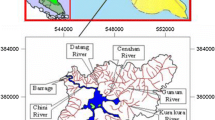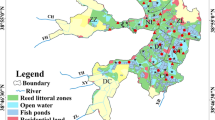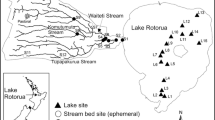Abstract
Suspended sediment and nutrient loadings from agricultural watersheds have lead to habitat degradation in Lake Takkobu. To examine their relationships with land-use activities, we monitored sediment, nutrient and water discharges into the lake for a 1-year sampling period. The Takkobu River contributed the largest portion of the annual water discharge into the lake, compared with the other tributaries. During dry conditions, lake water flowed into the Kushiro River, and conversely during flooding, Kushiro River water flowed into the lake. Inflows from the Kushiro River had a high proportion of inorganic matter, with high concentrations of total nitrogen and total phosphorus, attributed to agricultural land-use development and stream channelization practiced since the 1960s in the Kushiro Mire. Nutrient loadings from these two rivers were significantly higher during flooding than in dry conditions. However, there was no clear correlation between river discharge and nutrient concentrations. Since land-use activities in the Kushiro River and Takkobu River watersheds were concentrated near rivers, nutrients easily entered the drainage system under low flow conditions. In contrast, water discharged from small, forest-dominated watersheds contained a low proportion of inorganic matter, and low nutrient concentrations. The suspended sediment delivered to the lake during the sample period was estimated as approximately 607 tons, while the total nitrogen and total phosphorus inflows were about 10,466 and 1,433 kg, respectively. Suspended sediment input into the lake was 65%, and total nitrogen and total phosphorus were 40% and 48%, respectively, being delivered by the Kushiro River.
Similar content being viewed by others
References
Ahn, Y. S., Mizugaki, S., Nakamura, F., & Nakamura, Y. (2006). Historical change in lake sedimentation in Lake Takkobu, Kushiro Mire, northern Japan over the last 300 years. Geomorphology, 78, 321–334.
Bruton, M. N. (1985). The effects of suspensoids on fish. Hydrobiologia, 125, 221–241.
Cooper, J. R., Gilliam, J. W., Daniels, R. B., & Robarge, W. P. (1987). Riparian areas as filters for agricultural sediment. Soil Science Society of America Journal, 51, 416–420.
Faithful, J. W., & Griffiths, D. (2000). Turbid flow through a tropical reservoir (Lake Dalrymple, Queensland, Australia): Responses to a summer storm event. Lakes & Reservoirs: Research and Management, 5, 231–247.
Fisher, S., & Likens, G. E. (1973). Energy flow in Bear Brook, New Hampshire: an integrative approach to stream ecosystem metabolism. Ecological Monographs, 43, 421–439.
Foster, I. D. L., Dearing, J. A., Simpson, A., Carter, A. D., & Appleby, P. G. (1985). Lake catchment based studies of erosion and denudation in the Merevale catchment, Warwickshire, U.K. Earth Surface Processes and Landforms, 10, 45–68.
Grayson, R. B., Finlayson, B. L., Gippel, C. J., & Hart, B. T. (1996). The potential of field turbidity measurements for the computation of total phosphorus and suspended solids loads. Journal of Environmental Management, 47, 257–267.
Harris, L. D. (1988). The nature of cumulative impacts on biotic diversity of wetland vertebrates. Environmental Management, 12(5), 675–693.
Hayashibara, H., Kimura, N., & Ubukata, H. (2003). The density of aquatic insects in several lentic habitats in and around Kushiro marsh, Hokkaido, Japan: Comparisons among habitats and between years at ordinal and familial levels. Journal of Environmental Education, 6(2), 79–89 (in Japanese).
Hokkaido Institute of Environmental Sciences (Ed.) (2005). Lakes and marshes in Hokkaido: Revised edition. (Sapporo) (in Japanese).
House, W. A., & Warwick, M. S. (1998). Hysteresis of the solute concentration/discharge relationship in rivers during storms. Water Resources Research, 32(8), 2279–2290.
Inoue, T., & Ebise, S. (1991). Runoff characteristics of COD, BOD, C, N and P loading from rivers to enclosed coastal seas. Marine Pollution Bulletin, 23, 11–14.
Japan Meteorological Agency (2007). http://www.jma.go.jp/jma/index.html. (in Japanese).
Kallio, K., Kutser, T., Hannonen, T., Koponen, S., Pulliainen, J., Vepäläinen, J., et al. (2001). Retrieval of water quality from airborne imaging spectrometry of various lake types in different seasons. The Science of the total Environment, 268, 59–77.
Kameyama, S., Yamagata, Y., Nakamura, F., & Kaneko, M. (2001). Development of WTI and turbidity estimation model using SMA – application to Kushiro Mire, eastern Hokkaido, Japan. Remote Sensing of Environment, 77, 1–9.
Karakoç, G., Erkoç, F. Ü., & Katırcıoğlu, H. (2003). Water quality and impacts of sources for Eymir and Mogan Lakes (Turkey). Environment International, 29, 21–27.
Kira, T. (1997). Survey of the state of world lakes. In S. E. Jorgensen & S. Matsui (Eds.), Guidelines of lake management: the world’s lakes in crisis (Volume 8). (pp. 147–155). International Lake Environment Committee and United Nations Environment Programme.
Koponen, S., Pulliainen, J., Kallio, K., & Hallikainen, M. (2002). Lake water quality classification with airborne hyperspectral spectrometer and simulated MERIS data. Remote Sensing of Environment, 79, 51–59.
Lemly, A. D. (1982). Modification of benthic insect communities in polluted streams: combined effects of sedimentation and nutrient enrichment. Hydrobiologia, 87, 229–245.
Likens, G. E., Bormann, F. H., Johnson, N. M., Fisher, D. W., & Pierce, R. S. (1970). Effects of forest cutting and herbicide treatment on nutrient budgets in the Hubbard Brook watershed-ecosystem. Ecological Monographs, 40(1), 23–47.
Marsh, P., & Woo, M. K. (1981). Snowmelt, glacier melt, and high arctic streamflow regimes. Canadian Journal of Earth Sciences, 18, 1380–1384.
McDowell, W. H., & Likens, G. E. (1988). Origin, composition, and flux of dissolved organic carbon in the Hubbard Brook Valley. Ecological Monographs, 58(3), 177–195.
Mikami, H., Hino, S., Sakata, K., & Arisue, J. (2002). Variations in environmental factors and their effects on biological characteristics of meromictic Lake Abashiri. Limnology, 3, 97–105.
Mitikka, S., & Ekholm, P. (2003). Lakes in the Finnish Eurowaternet: status and trends. The Science of the total Environment, 310, 37–45.
Naiman, R. J. (1982). Characteristics of sediment and organic carbon export from pristine boreal forest watersheds. Canadian Journal of Fisheries and Aquatic Sciences, 39, 1699–1718.
Nakamura, F. (2003). Restoration strategies for rivers, floodplains and wetland in Kushiro Mire and Shibetsu River, northern Japan. Ecology and Civil Engineering, 5(2), 217–232 (in Japanese).
Nakamura, F., Kameyama, S., & Mizugaki, S. (2004). Rapid shrinkage of Kushiro Mire, the largest mire in Japan, due to increased sedimentation associated with land-use development in the catchment. Catena, 55, 213–229.
Nakamura, F., Mieko, J., Kameyama, S., & Mizugaki, S. (2002). Changes in riparian forest in the Kushiro Mire, Japan, associated with stream channelization. River Research and Applications, 18, 65–79.
Nakamura, F., Nakamura, T., Watanabe, O., Yamada, H., Nakagawa, Y., Kaneko, M., et al. (2003). The current status of Kushiro Mire and an overview of restoration projects. Japanese Journal of Conservation Ecology, 8, 129–143 (in Japanese).
Nakamura, F., Sudo, T., Kameyama, S., & Mieko, J. (1997). Influences of channelization on discharge of suspended sediment and wetland vegetation in Kushiro Marsh, northern Japan. Geomorphology, 18, 279–289.
Sato, H., & Terazawa, K. (2004). Change in the concentrations of fine solids in stream water after selective-cut logging in the forested catchment, central Hokkaido, Northern Japan. Journal of the Japanese Forest Society, 86(4), 349–357 (in Japanese).
Scanlon, T. M., Kiely, G., & Xie, Q. (2004). A nested catchment approach for defining the hydrological controls on non-point phosphorus transport. Journal of Hydrology, 291, 218–231.
Slaymaker, O. (1982). Land use effects on sediment yield and quality. Hydrobiologia, 91, 93–109.
Sly, P. G. (1994). Sedimentary processes in lakes. In P. Kenneth (Ed.), Sediment transport and depositional processes (pp. 157–191). Oxford: Blackwell Scientific Publications.
Takamura, N., Kadono, Y., Fukushima, M., Nakagawa, M., & Kim, B.-H. O. (2003). Effects of aquatic macrophytes on water quality and phytoplankton communities in shallow lakes. Ecological Research, 18, 381–395.
The government of Hokkaido (1904–1960). Monthly report of the meteorological observations. (Sapporo) (in Japanese).
Wass, P. D., & Leeks, G. J. L. (1999). Suspended sediment fluxes in the Humber catchment, UK. Hydrological Processes, 13, 935–953.
White, S., García-Ruiz, J. M., Martí, C., Alvera, B., & Barrio, G. D. (1997). Sediment transport in a high mountain catchment in the Central Spanish Pyrenees. Physics and Chemistry of the Earth, 22(3–4), 377–380.
Wilby, R. L., Dalgleish, H. Y., & Foster, I. D. L. (1997). The impact of weather patterns on historic and contemporary catchment sediment yields. Earth Surface Processes and Landforms, 22, 353–363.
Author information
Authors and Affiliations
Corresponding author
Rights and permissions
About this article
Cite this article
Ahn, Y.S., Nakamura, F. & Mizugaki, S. Hydrology, suspended sediment dynamics and nutrient loading in Lake Takkobu, a degrading lake ecosystem in Kushiro Mire, northern Japan. Environ Monit Assess 145, 267–281 (2008). https://doi.org/10.1007/s10661-007-0036-1
Received:
Accepted:
Published:
Issue Date:
DOI: https://doi.org/10.1007/s10661-007-0036-1




